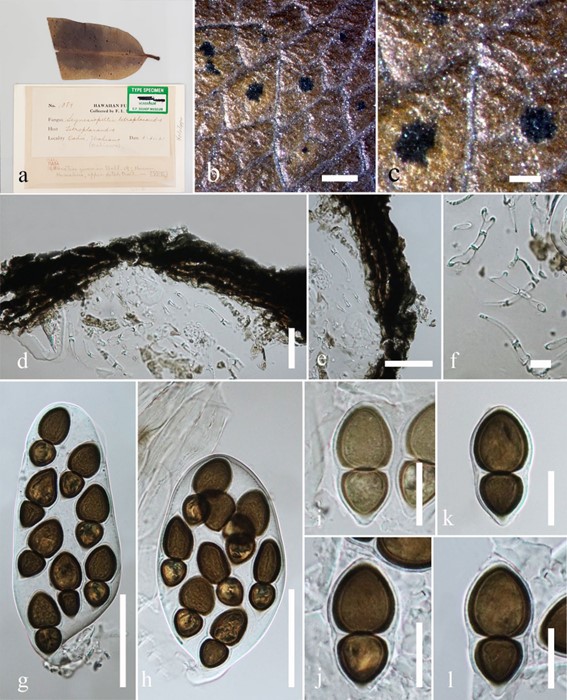Seynesiopeltis tetraplasandrae F. Stevens & R.W. Ryan, Bulletin of the Bernice P. Bishop Museum, Honolulu, Hawaii 19: 70 (1925).
MycoBank number: MB 158371; Index Fungorum number: IF 158371; Facesoffungi number: FoF 06523; Fig. 130
Foliar epiphyte on leaves, causing black spots, typically confluent, forming black colonies. Sexual morph: Mycelium superficial, sparse, septate, olive-green. Thyriothecia 347–483 µm diam. 438–565 µm high, solitary or gregarious, superficial, with a circular, shield-like, shallow, conical, dome-like, flattened, upper region, carbonaceous, unilocular, brown to black, basal layer poorly developed, lacking a distinct central ostiole. Upper wall comprising radiating parallel cells, cells at margin branching. Hamathecium comprising 1–3 µm wide, numerous, cellular, branched pseudoparaphyses. Asci 117–142 × 59–68 µm ( x̄ = 127 × 65 µm, n = 20), 8-spored, bitunicate, fissitunicate, saccate, with a knob-like pedicel and conspicuous ocular chamber. Ascospores 36–41 × 13–15 µm ( x̄ = 39 × 14 µm, n = 20) irregularly 2–3-seriate, dark brown when mature, 1-septate, strongly constricted at septum, upper cells longer and wider, basal cell shorter and narrower with an acute base, with a thick, structured, hyaline, cell wall. Asexual morph: Undetermined.
Material examined: USA, Hawaii, Oahu, Hamakua, upper ditch trail, on leaves of Tetraplasandra (Araliaceae), 31 May 1921, Stevens F.L. (BISH 1089, holotype).
Notes: Seynesiopeltis tetraplasandrae was introduced by Stevens and Ryan (1925). It was found on leaves of Tetraplasandra in Hawaii and was described as having unfree mycelium, round ascomata consisting several locules and lacking paraphyses. Further collections are required to resolve this genus.

Fig. 130 Seynesiopeltis tetraplasandrae (BISH 1089, holotype). a Details of herbarium material. b, c Habit and appearance of thyriothecia on the host surface. d Section of ascoma. e Peridium. f Hamathecium. g, h Asci. i–l Ascospores. Scale bars: b = 2000 µm, c = 500 µm, d = 25 µm, e = 35 µm, f = 10 µm, g, h = 50 µm, i–l = 20 µm
